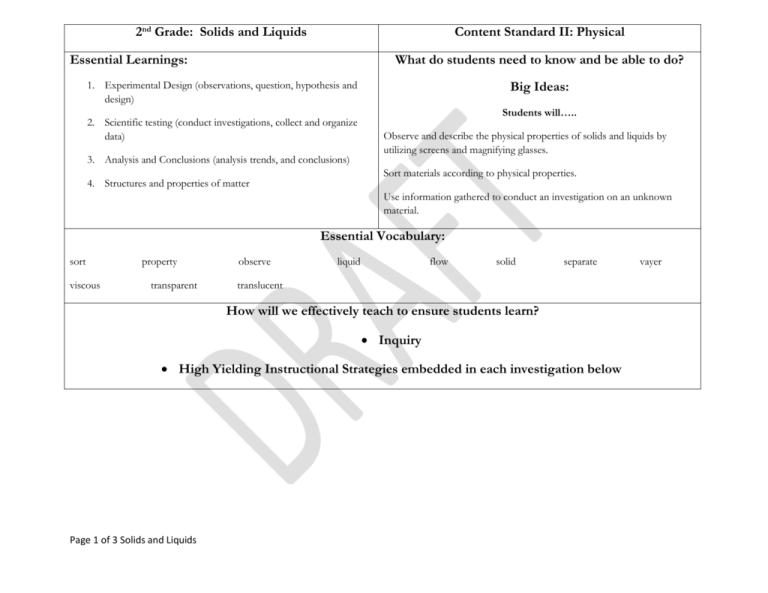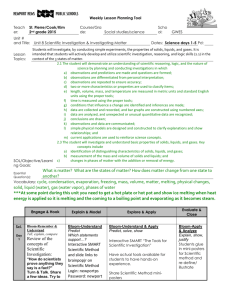2nd Grade: Solids and Liquids
advertisement

2nd Grade: Solids and Liquids Content Standard II: Physical Essential Learnings: What do students need to know and be able to do? Big Ideas: 1. Experimental Design (observations, question, hypothesis and design) 2. Scientific testing (conduct investigations, collect and organize data) 3. Analysis and Conclusions (analysis trends, and conclusions) Students will….. Observe and describe the physical properties of solids and liquids by utilizing screens and magnifying glasses. Sort materials according to physical properties. 4. Structures and properties of matter Use information gathered to conduct an investigation on an unknown material. Essential Vocabulary: sort viscous property transparent observe liquid flow solid separate translucent How will we effectively teach to ensure students learn? Inquiry High Yielding Instructional Strategies embedded in each investigation below Page 1 of 3 Solids and Liquids vayer Investigation 1: Solids Investigation 2: Liquids Essential Questions: Essential Questions: How can solids be described? How do liquids differ from each other? How does the same amount of liquid look in different shapes of containers? Part 1: Introduce Solids Part 2: Sort Solid Objects (optional) Part 3: Construct with Solids (optional) Investigation 3: Bits and Pieces Investigation 4: Solids and Liquids with Water Essential Questions: Essential Questions: How do you know when it is a solid or a liquid? How can a mixture of water and solids be separated? How can mixtures of solid particles be separated? What happens when water is mixed with different liquids? How are liquids the same? How do particles of solids move in bottles? Part 1: Liquids in Bottles (2 sessions needed) Part 1: Solids in Containers (2 sessions needed) Part 1: Solids and Water (3 sessions needed) Part 2: Properties of Liquids Part 2: Separating Soup Mix (2 sessions needed) Part 2: Liquids and Water (2 sessions needed) Part 3: Solids in Bottles (2 sessions needed) Part 3: Toothpaste Investigation (optional) Part 3: Liquid Level (2 sessions needed) Part 4: Separating Beads with a Screen How do we know if students are learning? Assessment: Use Assessment section of FOSS teacher’s manual. Page 2 of 3 Solids and Liquids What will we do if students don’t learn or if they are already performing at or above grade level? Science Extension opportunities provided in teachers manual Reteaching Strategies Suggested Time Frame: Scope and Sequence: 18 – 45 minute investigations (not including the optional activities). Student background knowledge would be from doing experiments in kindergarten on wood and paper in water. DRAFT Page 3 of 3 Solids and Liquids 5/8/2009







